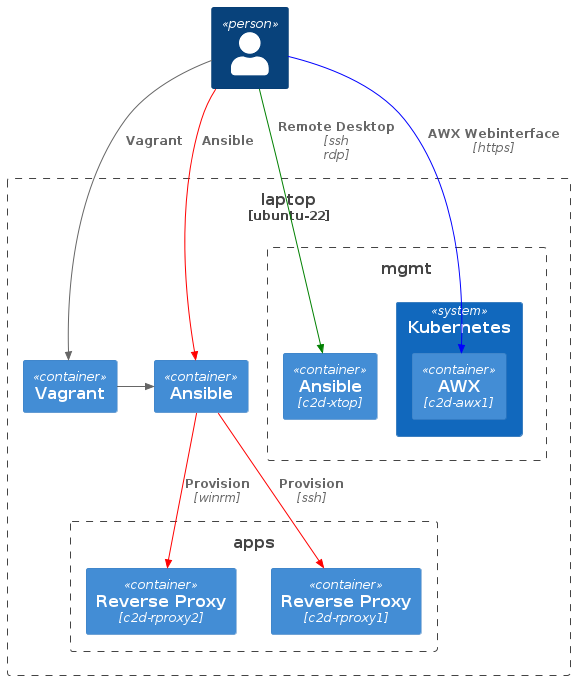Using Ansible without Vagrant
Categories:
Projects:
c2platform/ansible
This how-to describes how you can use
Ansible
without
Vagrant
in this project. This only requires a
little bit of SSH configuration in .ssh/config. The added bonus is that you
can SSH into boxes without Vagrant. In this setup the c2d-rproxy1 node starts
fulfilling a third role as a bastion / jump server
.
Overview
There are several ways to utilize
Ansible
within the
c2platform/ansible
project. These different approaches
are illustrated in the PlantUML diagram below. The default and most efficient
method is to employ
Vagrant
,
represented by the black line. Vagrant acts as a driver for Ansible through its
Ansible Provisioner
.
Another option we are currently exploring, depicted by the red line, is to use Ansible directly without Vagrant.
Additional options for utilizing Ansible include:
- Green Line: Utilizing the
c2d-xtopnode, which can be created (using Vagrant) by executingvagrant up c2d-xtop. Once created, you can connect to it using an RDP or SSH connection by executingvagrant ssh c2d-xtop. - Blue Line: Employing
AWX
. For more information, refer to the guide on setting up AWX:
Setup
AWX
.

SSH config
Edit .ssh/config and add entry shown below. This allows access to all nodes
using SSH hops via c2d-rproxy1.
Verify
Start c2d-rproxy1, c2d-rproxy2 and SSH into the node. Note: that we are
using ssh and not vagrant ssh, so we are bypassing Vagrant altogether.
vagrant up c2d-rproxy1 c2d-rproxy2
ssh c2d-rproxy1
ssh c2d-rproxy2
Now you should also be able to run Ansible directly, without Vagrant, for example with command similar to below.
source ~/.virtualenv/uwd/bin/activate
export ANSIBLE_CONFIG=$PWD/ansible-dev.cfg
ansible-playbook plays/mw/reverse_proxy.yml -i hosts-dev.ini --limit c2d-rproxy2
Example
See Manage the RWS Ansible Execution Environment for a practical example for which this is useful.
Feedback
Was this page helpful?
Glad to hear it! Please tell us how we can improve.
Sorry to hear that. Please tell us how we can improve.